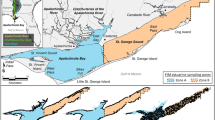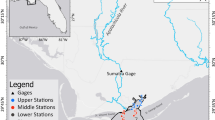Abstract
Salinity is an important determinant of estuarine faunal composition; previous studies, however, have indicated conflicting accounts of continuous vs. relatively rapid change in community structure at certain salinities from geographically distinct estuaries. This study uses a large fisheries monitoring database (n > 5,000 samples) to explore evidence for estuarine salinity zonation by nekton in the lower St. Johns River estuary (LSJR). There was little evidence to support the presence of estuarine salinity zones except at the extremes of the salinity gradient (i.e., 0.1–1.0 and 34–39). The LSJR estuarine nekton community exhibits progressively slow ecological change throughout most of the salinity gradient with rapid change at the interfaces with fresh and marine waters—an ecoline bounded by ecotones. This study affirms the rapid change that occurs at the extremes of the salinity spectrum in certain estuaries and is relevant to efforts to manage surface water resources and estuarine ecosystems. Given the disparity in the results of the studies examining biological salinity zones in estuaries, it would be wise to have, at minimum, a regional understanding of how communities are structured along the gradient from freshwater to marine.




Similar content being viewed by others
References
Able, K.W., D.M. Nemerson, R. Bush, and P. Light. 2001. Spatial variation in Delaware Bay (U.S.A.) marsh creek fish assemblages. Estuaries 24: 441–452.
Anonymous. 1958. The Venice System for the classification of marine waters according to salinity. Limnology and Oceanography 3: 346–347.
Baker, S.M., P. Baker, D. Heuberger, and L. Sturmer. 2005. Short-term effects of rapid salinity reduction on seed clams (Mercenaria mercenaria). Journal of Shellfish Research 24: 29–33.
Baltz, D.M., and R.F. Jones. 2003. Temporal and spatial patterns of microhabitat use by fishes and decapod crustaceans in a Louisiana estuary. Transactions of the American Fisheries Society 132: 662–678.
Boesch, D.F. 1977. A new look at the zonation of benthos along the estuarine gradient. In Ecology of marine benthos, ed. B.C. Coull, 245–266. Columbia: University of South Carolina Press.
Bray, J.R., and J.T. Curtis. 1957. An ordination of upland forest communities of southern Wisconsin. Ecological Monographs 27: 325–349.
Brody, R.W. 1994. Volume 6 of the lower St. Johns River basin reconnaissance: biological resources. Technical Publication SJ94-2. Palatka: St. Johns River Water Management District.
Browder, J.A., and D. Moore. 1981. A new approach to determining the quantitative relationship between fishery production and the flow of fresh water to estuaries. In Proceedings of the national symposium on freshwater inflow to estuaries volume I, ed. R. Cross and D. Williams, 403–430. Washington, DC: Fish and Wildlife Service. FWS/OBS-81/04.
Bulger, A.J., B.P. Hayden, M.E. Monaco, D.M. Nelson, and M.G. McCormich-Ray. 1993. Biologically-based estuarine salinity zones derived from multivariate analysis. Estuaries 16: 311–322.
Christensen, J.D., M.E. Monaco, and T.A. Lowery. 1997. An index to assess the sensitivity of Gulf of Mexico species to changes in estuarine salinity regimes. Gulf Research Reports 9: 219–229.
Clarke, K.R. 1993. Non-parametric multivariate analyses of changes in community structure. Australian Journal of Ecology 18: 117–143.
Clarke, K.R., and R.M. Warwich. 2001. Change in marine communities: an approach to statistical analysis and interpretation, 2nd ed. Plymouth: PRIMER-E.
Clarke, K.R., and R.N. Gorley. 2006. PRIMER v6: user manual/tutorial. Plymouth: PRIMER-E.
Comrey, A.L. 1973. A first course in factor analysis. New York: Academic Press.
Environmental Protection Board. 2009. State of the river report for the lower St. Johns River basin, Florida: water quality, fisheries, aquatic life, and contaminants. City of Jacksonville, August 2009.
Estevez, E.D., K. Dixon, and M.S. Flannery. 1991. West-coastal rivers of peninsular Florida. In The rivers of Florida, ed. R.J. Livingston, 187–221. New York: Springer.
Farrell, M.D., J. Good, D. Hornsby, A. Janicki, R. Mattson, S. Upchurch, et al. 2005. Technical report: MFL establishment for the lower suwannee river and estuary, little fanning, fanning, and manatee springs. Tampa: Water Resource Associates Inc.
Greenwood, M.F.D. 2007. Nekton community change along estuarine salinity gradients: can salinity zones be defined? Estuaries and Coasts 30: 537–542.
Iverson, R.L., and H.F. Bittaker. 1986. Seagrass distribution and abundance in eastern Gulf of Mexico coastal waters. Estuarine, Coastal and Shelf Science 22: 577–602.
Kelly, M.H. 2004. Florida river flow patterns and the Atlantic multidecadal oscillation. Brooksville: Southwest Florida Water Management Distric Report.
Kelly, M.H., and J.A. Gore. 2008. Florida river flow patterns and the Atlantic multidecadal oscillation. River Research and Applications 24(5): 598–616.
Kendall, D.G. 1971. Seriation from abundance matrices. In Mathematics in the archeological and historical sciences, ed. R.F. Hodson, D.G. Kendall, and P. Tautu, 215–242. Edinburgh: Edinburgh University Press.
Kendall, D.G. 1975. Review lecture: the recovery of structure from fragmentary information. Philosophical Transactions of the Royal Society, A 279: 547–582.
Livingston, R.J. 1988. Inadequacy of species-level designations for ecological studies of coastal migratory fishes. Environmental Biology of Fishes 22: 225–234.
McIvor, C.C., J.A. Ley, and R.D. Bjork. 1997. Changes in freshwater inflow from the Everglades to Florida Bay including effects on biota and biotic processes: A review. In Everglades: The ecosystem and its restoration, ed. S. Davis and J. Ogden, 117–146. Boca Raton: St. Lucie.
Morris IV, F.W. 1995. Volume 3 of the lower St. Johns River basin reconnaissance, hydrodynamics, and salinity of surface water. Technical Publication SJ95-9. Palatka: St. Johns River Water Management District.
Peebles, E.B., M.S. Flannery, R.E. Matheson Jr., and J.P. Rast. 1991. Fish nursery utilization of the little manatee river estuary (Florida): Relationships to physicochemical gradients and the distribution of food resources. In Proceedings, Tampa Bay area scientific information symposium 2, ed. S.F. Treat and P.A. Clark, 341–368. Tampa: Tampa Bay Regional Planning Council.
Quammen, M.L., and C.P. Onuf. 1993. Laguna Madre: seagrass changes continue decades after salinity reduction. Estuaries 16: 302–310.
R Development Core Team. 2008. R: A language and environment for statistical computing. Vienna: R Foundation for Statistical Computing.
Remane, A., and C. Schlieper. 1971. Biology of Brackish Water, 2nd ed. New York: Wiley.
Sagan, J.J. 2009. A summary of submerged aquatic vegetation (SAV) status within the lower St. Johns River: 1996–2007. Special Publication SJ2009-sp6. Palatka: St. Johns River Water Management District.
Sklar, F.H., and J.A. Browder. 1998. Coastal environmental impacts brought about by alterations to freshwater flow in the Gulf of Mexico. Environmental Management 22: 547–562.
Tabachnik, B.G., and L.S. Fidell. 1989. Using multivariate statistics. New York: Harper and Row.
Turner, R.E. 2006. Will lowering estuarine salinity increase Gulf of Mexico oyster landings? Estuaries and Coasts 29: 345–352.
Wright, D.H. 1991. Correlations between incidence and abundance are expected by chance. Journal of Biogeography 18: 463–466.
Acknowledgments
We thank the field crews of the Florida Fish and Wildlife Conservation Commission, Fish and Wildlife Research Institute's Fisheries-Independent Monitoring Program for the countless hours of data collection. We thank Phil Stevens and Dave Blewett for their constructive comments and contributions to the final manuscript. This study was supported in part by contract 25303 from the St. Johns Water Management District to the Florida Fish and Wildlife Conservation Commission and by funds collected from the State of Florida Recreational Saltwater Fishing License sales. The statements, findings, views, and conclusions are those of the authors and are not necessarily the views of the District.
Author information
Authors and Affiliations
Corresponding author
Rights and permissions
About this article
Cite this article
Guenther, C.B., MacDonald, T.C. Comparison of Estuarine Salinity Gradients and Associated Nekton Community Change in the Lower St. Johns River Estuary. Estuaries and Coasts 35, 1443–1452 (2012). https://doi.org/10.1007/s12237-012-9544-5
Received:
Revised:
Accepted:
Published:
Issue Date:
DOI: https://doi.org/10.1007/s12237-012-9544-5




